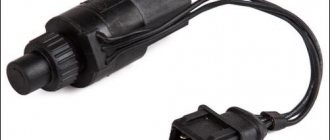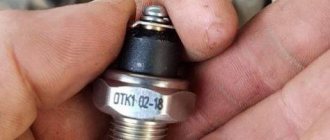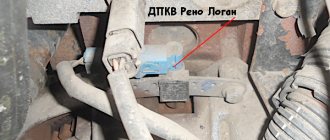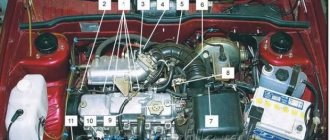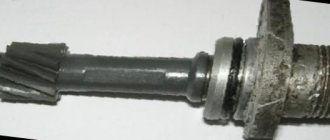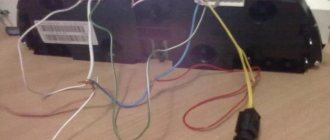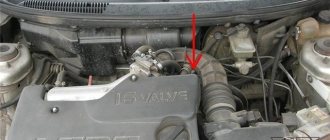The speed sensor (DS) is designed to obtain information about the number of revolutions transmitted from the gearbox to the drive wheels of the vehicle, followed by its conversion into an electronic signal and transmission to the electronic control unit (ECU). Only fuel-injected cars are equipped with DS. The predecessor of the speed sensor was a mechanical speedometer drive, which was equipped with all carburetor engines.
VAZ 2110 cars, depending on the year of manufacture, are equipped with different types of speed sensors. Older models are equipped with a mechanically driven sensor (rod and gear), new ones (after 2006) have a fully electronic design.
Electronic speed sensor
Speed sensor malfunctions
Signs of a sensor malfunction may include:
- unstable operation and incorrect speedometer and odometer readings;
- cessation of stable engine operation at idle;
- errors generated by the computer (P0500 – no sensor signal, P0503 – intermittent sensor signal).
The problems listed above may result from:
- poor contact in the sensor connector due to contamination;
- violation of the integrity of the wiring from the sensor to the ECU;
- mechanical failure of the DS drive (in older VAZ 2110 models).
Do I need to change
Not only the speedometer and odometer readings, but also the quality of the fuel mixture supplied to the cylinders, the idle speed of the vehicle, engine stability and fuel consumption depend on the information received by the ECU from the sensor.
A failed DS will “confuse” the electronic unit, which simply will not understand whether the car is moving or standing still. As a result, the speed will begin to fluctuate, the engine will stall at idle, and fuel consumption will increase.
Checking a mechanically driven speed sensor is not difficult. On the removed sensor, we find the pin and turn it with pliers, having attached the connector to it in advance. If the speed sensor is working, the arrow on the instrument cluster will jump, if there is no reaction, then there is a problem with the drive or electrical wiring.
Checking the wiring to the instrument cluster is also not difficult, take a paperclip (you can use any other metal object) and insert it into the middle pin on the connector, then touch it to the engine housing, the arrow on the combination should twitch, otherwise you need to look for the cause in a wiring fault or sensor connector (oxidation, breakage, etc.).
Video.
Schematic electrical diagrams, connecting devices and pinouts of connectors
The speed sensor is an element of the vehicle's electronic control system. It depends on its readings how much fuel will be supplied, how much air will bypass the throttle valve when idling, and what the speedometer readings will be.
The speed sensor of a VAZ car is based on the use of the Hall effect, that is, a stream of pulses is transmitted from the device to the car's ECU, the frequency of which is proportional to the speed of the car. Auto electronics, analyzing incoming data, selects the required idle speed and sends a signal to a device that regulates the engine idle speed, which optimizes the composition of the air-droplet mixture entering the combustion chamber, bypassing the throttle valve.
During a distance of one kilometer, the speed sensor transmits over 6000 pulses to the ECU. Based on the parameters of the time analysis of inter-pulse signals, the on-board computer transmits data to the dashboard, thereby determining the speedometer readings.
As in many other cars, the VAZ speed sensor is located in the upper part of the gearbox housing, not far from the engine oil level dipstick. You can get to it from two sides: from above, by opening the hood and disconnecting the adsorber, and from below, using the inspection hole for convenience.
Replacement price
If the breakdown is not due to dirty contacts or broken wiring, it is better to replace the sensor. Moreover, it costs 170-400 rubles, depending on the type and manufacturer. The cost of replacing it at a service station is 100-150 rubles.
Sensor part numbers:
- with mechanical drive - 2110-3843010F;
- electronic (new) - 2170-3843010.
When choosing a DS, pay attention to where it was manufactured. If a mechanically driven sensor requires replacement, under no circumstances buy Asian analogues - the drive gear is made of very low quality plastic. It happens that it breaks on the third day of use. In this case, you will have to disassemble the entire box to remove its fragments.
It is better to purchase a sensor with an all-metal drive.
DIY replacement instructions
Now let's take a look at the procedure for replacing the device. Before replacing, you need to buy a new sensor. It is best to purchase a DC with a metal rod - such devices are considered more reliable and usually work much longer. There is nothing complicated about the replacement; the procedure is described in detail below (video published by user Inzil Nazmutdinov).
Stages
How to change the speed sensor on the “Ten”:
- First of all, you should turn off the voltage in the vehicle's electrical network. Turn off the ignition, then open the engine compartment and disconnect the battery terminal.
- Then find the speed sensor and disconnect the wire with the connector from it. When disconnecting, it is advisable to remember the pinout of the contacts on the plug in order to connect the device correctly.
- As for removing the speed sensor, you can simply unscrew it by hand. If the device is fixed in the seat too tightly, then to dismantle it you will need a wrench of size 21 or 22. The size is inaccurate, since the design of the device and, accordingly, the dimensions may differ.
- After dismantling, we recommend that you check the correct operation of the drive itself. To do this, unscrew the nut that secures it to the transmission box. Remove the drive carefully, since its rod should under no circumstances get into the gearbox housing, otherwise you will need to dismantle and disassemble it.
- Install the new speed sensor; the installation procedure for all components is carried out in reverse order.
Photo gallery “Changing DS with your own hands”
Replacement
The process of replacing a diesel engine is very simple, and even the most uninitiated car owner can cope with it.
- key to 21;
- key to 10;
- crosshead screwdriver.
Execution procedure for VAZ 2110 with drive sensors.
1.Raise the hood, disconnect the “-” terminal on the battery.
2. Determine the location of the sensor. For both old and new models, it is located on the back of the engine at the top of the gearbox.
3.If necessary, use a screwdriver to loosen the corrugation clamp, remove it, and move it aside.
4.Squeezing the antennae on the sensor connector, disconnect
5.Use your hands or using a 21 wrench to unscrew the sensor.
6.Using a 10mm wrench, unscrew the nut securing the DS drive and carefully remove it.
7.If the drive is in order, you can leave the old one, but if it has traces of mechanical stress, we replace it.
8. Having installed the drive, install a new sensor by screwing it clockwise.
9.Connect the connector, connect the corrugation, and the negative terminal.
Changing the electronic sensor
1.De-energize the vehicle's on-board circuit.
2. Using a screwdriver, loosen the corrugation clamp and remove it.
3. Disconnect the wires from the DC by moving the latch.
4.Using a 10mm wrench, unscrew the sensor mounting nut.
5.Remove the old sensor, install the new one, tighten the nut.
7.Connect the ground terminal.
Usually installing a new sensor solves all problems associated with it. The engine begins to operate in normal mode, and the speedometer and odometer show accurate information. If the problem does not disappear after installing a new DS, look for it elsewhere.
Any car is equipped with a system that shows the speed of movement and mileage (distance traveled). It is the speedometer, which is a device for determining instantaneous speed, that makes it possible to find out what the maximum speed of the VAZ 2110 is.
Speed sensors are installed only in fuel-injected cars; where carburetor engines are present, they are not present. This device is responsible for the supply and consumption of fuel, setting the ignition timing, and monitors the quality of the combustible mixture. All data is transmitted to the electronic control unit, which controls the injector.
Speedometer drive: types and differences
A speedometer is an important element in cars, as well as several other vehicles, as it is necessary to monitor speed in order not to violate traffic rules. But this is not the last function of this device.
All possible speedometers have a high-speed magnetic unit; due to the rotation of the magnets, a flow is formed, it moves through the coil, thereby facilitating the induction of eddy currents. They thereby begin to create more magnetic fields. They interact with each other, the needle of the device moves along the frequency scale, with the help of this the magnet rotates.
All speedometers are divided into three categories.
- Mechanical speedometers.
- Electromechanical speedometers.
- Electronic speedometers.
Mechanical speedometers. In this type of speedometer, the process of speed measurement and indication occurs thanks to a mechanical device. A gear is used as sensors, which is connected to the secondary shaft of the gearbox; this is the speed unit with an arrow indicator and the drum counter. Previously, speedometers were used in the form of a drum and tape. But they stopped using them quite a long time ago.
Electromechanical speedometers. In these devices, speed is measured using various electronic or electromechanical sensors that are connected to the gearbox. The speed is indicated by a milliammeter or the speed unit of a mechanical speedometer, and the distance is indicated by a counting drum, which drives a stepper motor.
We recommend:
The principle of operation of an automatic transmission, what to do if it breaks down
Electronic speedometers. This is a development of new electromechanical speedometers; the main difference is the replacement of the odometer - in an electronic device it is completely digital.
Speed sensor VAZ 2110 16 valves signs of malfunction
Damage may occur:
- the presence of interruptions in operation, false data in the readings of devices for determining speed and measuring the number of wheel revolutions;
- lack of stable engine operation at idle;
- a lit Check Engine light on the dashboard;
- stopping the computer from issuing errors about the absence or interruption of sensor signals (P0500 and P0503).
These problems arise for various reasons: the sensor connectors are dirty, the contact or integrity of the wire connecting the computer to the sensor is broken.
Signs of trouble
If the odometer suddenly refuses to work, and the speedometer works jerkily, or “lies” regarding speed and mileage, these are direct indications that the speed sensor or its drive is failing. It may also be that there are problems in the electrical circuit, the connector is failing, the pinout is confused, if the operation of this system has been interfered with, etc.
In addition, an indirect indication of a malfunction may be that the car stalls at idle (although there may be other reasons for this).
Read
Naturally, if the speedometer begins to give false readings in advance, and the “CHECK ENGINE” light is on on the dashboard, then the reason is the speed sensor.
Is replacement always necessary?
The information transmitted by the speed sensor to the ECU is very important; the readings of the instruments discussed above depend on it.
This information also affects the quality of the fuel mixture supplied to the cylinders, the idle speed, the stability of the engine and the amount of fuel consumed. If the sensor malfunctions, the electronic unit will not be able to determine whether the car is moving or stationary. In this case, floating speeds are observed, the engine begins to stall, and fuel consumption will become much higher.
Carrying out a vehicle inspection is available to every car enthusiast. To find a fault, you need to know where exactly it is located in the VAZ-2110. The sensor is located in the engine compartment under the hood, in the engine compartment. Nearby is the exhaust manifold (and on the VAZ-2112 there are 16 valves, it is located in the upper part of the gearbox, fully visible and accessible from the engine compartment).
The wires rub against the commutator and this can cause damage. Sometimes it is sufficient to isolate them and position them so that there is no contact with the collector.
Don’t forget about a broken cable, which can cause a breakdown. If this problem is absent, then you need to look for it in the sensor itself or in its drive.
To successfully replace the VAZ-2110 speed sensor, the speedometer's functionality is first restored.
Principle of operation.
The principle of operation of the VAZ 2110 speed sensor is based on the Hall effect: by transmitting electrical impulses (in VAZ cars, by the way, only 6 such impulses are used) to the ECU, the sensor informs it about the rotation speed of the driving rollers of the machine, on the basis of which the control unit not only acts to the speedometer needle/mileage display, but also monitors engine operation by sending the necessary signals to the idle speed controller and throttle position sensor.
How much does a replacement cost?
If the wiring and contacts are in order, the sensor must be replaced. Its cost varies from 170 to 400 rubles. They will also charge a little for a replacement, from 100 to 150.
To purchase, you need to know the sensor numbers in the catalog. Part number 2110-3843010F corresponds to a mechanically driven sensor, and number 2170-3843010 corresponds to an electronic one. It is advisable to choose sensors with the designations “–”, “A”, “+”, and not 1, 2, 3, this will help you make the pinout faster. It is necessary to pay attention to the manufacturer so as not to purchase a low-quality product. The drive must be completely metal.
Preparing for replacement
In order for the replacement of the VAZ 2110 speed sensor to be successful and bring the expected result, first of all - the resumption of normal operation of the speedometer, you need to prepare for it, then carry it out correctly.
When choosing a new sensor, pay attention: it is desirable that each connector inside the block has the designations “-, then A and +” instead of the usual 1, 2, 3. Although this does not seem to have any fundamental significance, this way the pinout will be carried out faster, and , most importantly, it’s correct.
Another important point is to choose a device with a metal stem, which will last much longer than the six months “allotted” for a plastic one. Don’t forget to check how the rod rotates, whether there is any play in it, and whether you forgot to equip it with a washer.
Step-by-step replacement of the VAZ-2110 speed sensor with 8 and 16 valves
In order to change the speed sensor yourself, it is enough to have two or three keys (10, 21, 22) and a Phillips screwdriver on hand.
- The current in the car is turned off; to do this, remove the connector from the battery.
- The wire connector is disconnected from the sensor; it is recommended to remember the pinout.
- The sensor can be unscrewed manually, or using keys 21 or 22 (depending on the design).
- The condition of the drive is studied. After the sensor is removed, using a 10mm wrench, unscrew and remove the nut that secures the sensor drive.
- A drive with mechanical damage must be replaced; if there is none, you can leave it the same.
- Installation of a new device should be done in reverse order.
- The new drive has a rubber attachment that needs to be lubricated with transmission oil.
- After installation, it is recommended to check the polarity of the wires using a multimeter. If the contacts are suddenly mixed up, they are swapped.
- It remains to be checked. This is done either with the car running or with the wheels suspended.
Repair and replacement
We carry out dismantling according to the following scheme:
- We de-energize the car by removing the “-” connector from the battery;
- We disconnect the wire connector from the sensor and remember what their pinout is;
- We unscrew the sensor itself by hand. If this doesn’t work, use key 21 or 22 (there may be design differences);
- At the same time, we check how the drive feels. After removing the sensor, you need to unscrew the nut with which the drive is attached to the gearbox. You need to remove it very carefully, since if you drop the rod into the gearbox, you will have to disassemble it too. The new drive has a rubber ring, which is lubricated with transmission oil before installation.
We install new devices in the reverse order. Again, the pinout of the wires is of particular importance.
Inside the block we look at how the pinout is marked. And using a multimeter with the ignition on, we determine which connector goes to which wire.
If the multimeter shows “minus”, and you connected this wire to the plus connector, then you urgently need to change the polarity. In this regard, it is better to take the block that we recommend.
But if there isn’t one, you can use the regular one. In this case, the pinout is as follows: 1 – “+”, 2 – signal output, 3 – “-”.
The drive is checked, as well as the operation in general while the car is moving, or with the front wheels hanging.
Replacing the VAZ 2110 speed sensor
The main cause of speedometer problems is the failure of the speed sensor, and if the DS is faulty, it must be replaced. It is not difficult to replace the sensor on a VAZ “ten”; almost any driver can do this work independently. The operation is especially simple on a car with an 8-valve engine. Let's start replacing:
- we place the car on a flat horizontal plane; you can do without a pit or a car lift;
- we find the sensor - it is located on top of the gearbox housing, not far from the oil dipstick;
- to disconnect the plug from the sensor, press on the locking bracket;
- Using a 22mm key, we unscrew the sensor itself counterclockwise, often the DS is unscrewed by hand;
- When installing a new part, we use manual force; it is not recommended to tighten the DS with a wrench, as you can break the part or strip the thread.
When installing, we put the connector in place, it should click into place, and the work can be considered complete. With sufficient skill, this operation is completed in 5-10 minutes.
Car owners often encounter a problem when, after replacing the sensor, the speedometer needle begins to “lie” - show the wrong speed. It should be noted that several types of DS have been developed for the VAZ Tens, and they have different catalog numbers. When purchasing, you should pay attention to the number of the failed sensor, and you must purchase a new part only with the same marking.
Replacing the electronic sensor
The onboard circuit is de-energized, the clamp is loosened and the corrugation is removed. Then the wires from the speed sensor are disconnected and the latch is removed. Next, using a 10mm wrench, unscrew the nut that secures the sensor.
The old sensor is replaced with a new one, the nut is tightened, the corrugation is connected, and the ground terminal is connected.
After this, the engine should begin to operate in its usual mode, which means that the replacement of the VAZ 2110 speed sensor was successful and normal operation of the devices has been resumed.
How to check the DS for performance?
If the DS does not work or works but incorrectly, then you need to check the device. There are several options for diagnosing a device, we recommend that you familiarize yourself with each of them.
The first method, to implement it you will need a tester - a voltmeter:
- The DS is dismantled from its seat in the car.
- Then you'll need the tester itself. One of its contacts must be connected to the device connector, in particular, to the contact through which signals are output to the control unit. The other contact of the tester must be grounded; to do this, connect it to the car body or the cylinder head of the engine.
- Now twist the controller - you need to make sure there are presence or absence of pulses in the operating cycle and change the output voltage parameter. To determine, you need to install a piece of tube on the DS axis, and rotate it at a speed of about 3-5 km/h. The higher the rotation speed of the device, the higher the frequency and voltage value should be on the tester display (video filmed by the Autoelectrics HF channel).
Another verification method; to perform it, the controller does not need to be removed from the car:
- The front of the car must be placed on a jack, with one wheel raised so that it does not touch the ground.
- The controller contacts must be connected to the tester terminals.
- After this, spin the wheel, while watching the readings on the tester. If there is voltage and the frequency is measured in Hz, then this indicates that the DS is working.
If you don’t have a tester, you can use the diagnostic method using a test lamp:
- First, you need to disconnect the connector with the device's power cable from the controller.
- Turn on the ignition and locate the positive and negative contacts on the connector.
- Then one wheel must be suspended using a jack.
- Next, you need to connect the wire of the control light to the signal contact of the speed sensor and turn the wheel by hand. If you notice that the light comes on when cranking, then the DS is operational.
9.1.6 Removing and installing the speedometer drive
1. Support the rear wheels with wheel chocks, then jack up the front of the car and place it on stands. The speedometer drive is located at the rear of the transmission, near the differential entry point of the right drive shaft. Depending on the model configuration, the drive may have a mechanical (cable) design or be an electronic sensor. 2. On models with a cable-driven speedometer, remove the fastening pin and disconnect the cable from the drive gear. On other models, disconnect the associated electrical wiring.
3. Unscrew the mounting bolt and remove it together with the heat shield (if provided).
4. Remove the drive assembly with the driven gear from the manual transmission housing and remove it along with the sealing ring.
5. If necessary, the gear can be removed from the gearbox housing (do not forget to remove the oil seal); check the condition of the gear; if mechanical defects are detected, replace it. Be sure to replace the O-ring. 6. If signs of wear or damage to the driven gear are detected, the condition of the drive gear should also be checked.
What to do if the speedometer does not work on a VAZ-2110 with an injector
As you know, devices installed in a car allow you to monitor the situation while driving on the streets and monitor the operation of the engine and all other systems.
Among others, the speedometer occupies a special place. It is located on the dashboard directly above the steering wheel. With its help, the driver finds out at what speed the car is moving. In a situation when the speedometer and the injector installed on the VAZ-2110 do not work properly, the person behind the wheel puts both his own health and the lives of passengers at risk. At the same time, he can easily “earn” a fine from a traffic police officer for speeding too high. Thus, a working speedometer allows you to avoid a considerable amount of trouble.
Sensor pinout
Damage to the speed sensor wiring is a fairly common problem, since it is located quite low and this leads to the destruction of its wires and, therefore, to their unusability. To restore the wiring, you need to know the pinout of the DS VAZ 2110.
Sensor pinout
Connector pinout
Why does the speedometer break?
It is worth noting that in some cases it is not difficult to repair the speedometer yourself.
In others, you will need the help of specialists. Thus, oxidation of contacts is considered a fairly easy to fix fault. It is characterized by the “jumping” of the arrow, despite the fact that the speed of movement remains stable. The problem is resolved by cleaning the contacts.
The wires are frayed. This reason can be suspected by the chaotic movement of the needle when starting the engine. Meanwhile, experts note that sometimes the problem does not manifest itself for a long time. It can be identified using a tester.
Sensor failure. A speed control device whose performance is questioned is replaced with a known good one. If the speedometer begins to function normally after this procedure, then there is no point in further looking for damage. Often sensors become unusable after their housing is destroyed and water or dirt gets inside.
Connectors. They are located in the VAZ-2110 in a place where they are constantly exposed to dirt. As a result, the contact is broken and the speedometer needle moves chaotically. The connectors must be completely cleaned and the connection must be checked for reliability.
Often the speedometer also begins to malfunction due to shaft wear. In this situation, it will be possible to get rid of the problem only after completely replacing the above-mentioned part.
Frequent causes of speedometer drive failure
- Long service life - each device has its own service life.
- Something fell on the sensor and damaged its connection.
- The wires have dried out or the contact has simply come loose, which prevents the device from working.
- Complex design features of use, increased amount of humidity and constant contamination of the space under the hood.
- Installing a device of poor quality or purchasing a cheap speed sensor without special qualities and characteristics.
Speedometer on VAZ-2110
As you know, the manufacturer installs an electronic speedometer on this model. If it has become unusable, then this problem is quite serious, since the above-mentioned device itself is not for sale. For this reason, you will have to buy a whole shield. However, in fact, in nine out of ten cases the problem is in a completely different place.
On a VAZ-2110 with an 8-valve engine, the speedometer receives information from the speed sensor. It, in turn, is located in the gearbox. There, through two gears, it receives torque data from the gearbox shaft.
Everything works similarly for cars with 16-valve engines.
Most often, as noted above, the problem is that the sensor is too dirty. In general, dust always accumulates under the hood of the VAZ-2110. It, when mixed with oil, creates a fairly stable barrier. As a result, the reliability of the speedometer readings becomes unconditional. The problem is easily solved - the sensor is cleaned and dried.
It is worth recalling that it will be more convenient to access it directly through the gearbox, since doing this from below is very inconvenient.
Another very common reason is problems with the electrical network. It all needs to be checked. In addition, attention is also paid to:
- reliable fastening of wiring in terminals;
- their general condition;
- fuses located within the mounting block.
Troubleshooting
First of all, you need to know where the VAZ 2110 speed sensor is located, and then check its drive. It is located under the hood, in the engine compartment, next to the exhaust manifold. It is against the heated collector that wires sometimes rub and melt.
The result is a short circuit. Usually it is enough to insulate the wires, then route them so that they do not touch the collector.
Check if the cable is broken; this is also one of the possible causes of breakdowns. If your visual check does not produce results, then you need to change the sensor or its drive.
